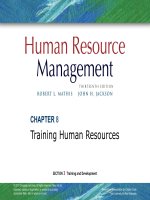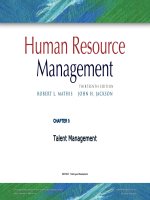Human resrouce management 12th mathis jacson chapter 003
Bạn đang xem bản rút gọn của tài liệu. Xem và tải ngay bản đầy đủ của tài liệu tại đây (1.11 MB, 26 trang )
CHAPTER 3
Organization/Individual
Relations and Retention
© 2008 Thomson/South-Western All rights reserved.
PowerPoint Presentation by Charlie Cook
The University of West Alabama
Chapter
Chapter Objectives
Objectives
After you have read this chapter, you should be able to:
■ Identify the changing nature of the psychological
contract.
■ Discuss how motivation is linked to individual
performance.
■ List the five major drivers of retention and activities
related to them.
■ Describe different kinds of absenteeism and turnover.
■ Explain two ways to measure absenteeism and turnover.
■ Outline the steps in managing retention.
© 2008 Thomson/South-
3–2
Individual/Organizational Relationships
• The Psychological Contract
The unwritten expectations employees and employers
have about the nature of their work relationships.
Affected by age of employee and changes in
economic conditions.
Focuses on expectations about “fairness” that may
not be defined clearly by employees.
• Psychological Ownership
When individuals feel that they have some control and
perceived rights in the organization, they are more
likely to be committed to the organization.
© 2008 Thomson/South-
3–3
Components of the Psychological Contract
Employers provide:
Employees contribute:
• Competitive compensation
and benefits
• Continuous skill improvement
and increase productivity
• Flexibility to balance work
and home life
• Reasonable time with the
organization
• Career development
opportunities
• Extra effort when needed
© 2008 Thomson/South-
3–4
FIGURE 3-1
Factors Affecting Job Satisfaction and Organizational Commitment
© 2008 Thomson/South-
3–5
Job Satisfaction, Loyalty, and Commitment
• Job Satisfaction
A positive emotional state resulting from evaluating
one’s job experience.
• Organization Commitment (Loyalty)
The degree to which employees believe in and accept
organizational goals and desire to remain with the
organization.
Continuance commitment: the likelihood that an
individual will stay with rather than withdraw from the
organization.
© 2008 Thomson/South-
3–6
Individual Employee Performance
• Individual Performance Factors
1. Individual ability to do the work
2. Effort level expended
3. Organizational support
Performance (P) = Ability (A) x Effort (E) x Support (S)
© 2008 Thomson/South-
3–7
FIGURE 3-2
Components of Individual Performance
© 2008 Thomson/South-
3–8
Individual Motivation
• Motivation
The desire within a person causing that person to act
to reach a goal.
• Management Implications for Motivating
Individual Performance
Broad-based strategies and tactics to address
individual employee concerns about:
Consistency
in organizational rewards
Organizational
Accurate
support for employee efforts
measurement of employee performance
Desirability
of rewards by employees
© 2008 Thomson/South-
3–9
Retention of Human Resources
• Myths About Retention
1. Money is the main reason people
leave.
2. Hiring has nothing to do with
retention.
3. If you train people, you are only
o
I’m G
ne
training them for another employer.
4. Do not be concerned about retention
during a merger.
5. If solid performers want to leave, the
company cannot hold them.
© 2008 Thomson/South-
3–10
Retention of Human Resources
• Why People Stay or Leave—Links, Fit, and
Sacrifice
Culture and values
Positive,
distinctive company that is well-managed,
and offers exciting challenges.
Attractive job
Freedom and autonomy, exciting challenges, and
career advancement and growth
Compensation and lifestyle
Differentiated pay package, high total
compensation, geographic location, and respect for
lifestyle
© 2008 Thomson/South-
3–11
FIGURE 3-3
Drivers of Retention
© 2008 Thomson/South-
3–12
FIGURE 3-4
Some Characteristics of People and Jobs
© 2008 Thomson/South-
3–13
Employee Absenteeism
• Absenteeism
Any failure to report for work as scheduled
or to stay at work when scheduled.
Involuntary absenteeism
Unavoidable
with understandable cause
(e.g., actual illness)
Voluntary absenteeism
Avoidable
without justifiable
cause (e.g., feigning illness)
© 2008 Thomson/South-
3–14
FIGURE 3-5
Reasons for Unscheduled Absences
Source: Based on data from “2006 CCH Unscheduled
Absence Survey,” CCH, Inc., October 26, 2006,
www.cch.com/press/news/2006. All Rights Reserved.
Reprinted with permission.
© 2008 Thomson/South-
3–15
Controlling Absenteeism
Disciplinary
approach
Positive
reinforcement
Controlling
Absenteeism
Paid time-off
(PTO)
Combination
approach
“No fault”
policy
© 2008 Thomson/South-
3–16
FIGURE 3-6
Employee Absenteeism Control Actions
© 2008 Thomson/South-
3–17
Employee Turnover
• Turnover
The process in which employees leave an
organization and have to be replaced.
• Impact of Turnover
Inability to achieve business goals
Loss of “image” to attract other individuals
High costs of turnover and replacement
Churn—hiring
new workers while laying off others
© 2008 Thomson/South-
3–18
Types of Turnover
Involuntary
Controllable
Voluntary
Turnover
Uncontrollable
Functional
Dysfunctional
© 2008 Thomson/South-
3–19
HR Metrics: Measuring Absenteeism
• Measuring Absenteeism
U.S. Department of Labor formula:
Number of person-days lost through job absence during period
×100
(Average number of employees) × (Number of work days)
• Other Measures of Absenteeism:
Incidence rate—absences per 100 employees each day
Inactivity rate—percentage of time lost to absenteeism
Severity rate—average time lost per absent employee
during a specified period of time
© 2008 Thomson/South-
3–20
HR Metrics: Measuring Absenteeism
(cont’d)
• Calculations of the costs of absenteeism should
usually include:
Lost wages
Benefits
Overtime for replacements
Fees for temporary employees, if incurred
Supervisor’s time
Substandard production
Overstaffing necessary to cover absences
© 2008 Thomson/South-
3–21
HR Metrics: Measuring Turnover
• Computing the Turnover Rate:
Number of employee separations during the month
× 100
Total number of employees at midmonth
• Costs of Turnover
Separation costs
Replacement costs
Training costs
Hidden costs
© 2008 Thomson/South-
3–22
HR Metrics: Measuring Turnover (cont’d)
• Ways to Measure Turnover:
Job and job levels
Department, units, and location
Reason for leaving
Length of service
Demographic characteristics
Education and training
Knowledge, skills and abilities
Performance ratings/levels
© 2008 Thomson/South-
3–23
FIGURE 3-7
Simplified Turnover Costing Model
Teller
(40%)
20,000
8,000
28,000
20
3
3,500
70,000
© 2008 Thomson/South-
3–24
FIGURE 3-8
Managing
Retention
© 2008 Thomson/South-
3–25









